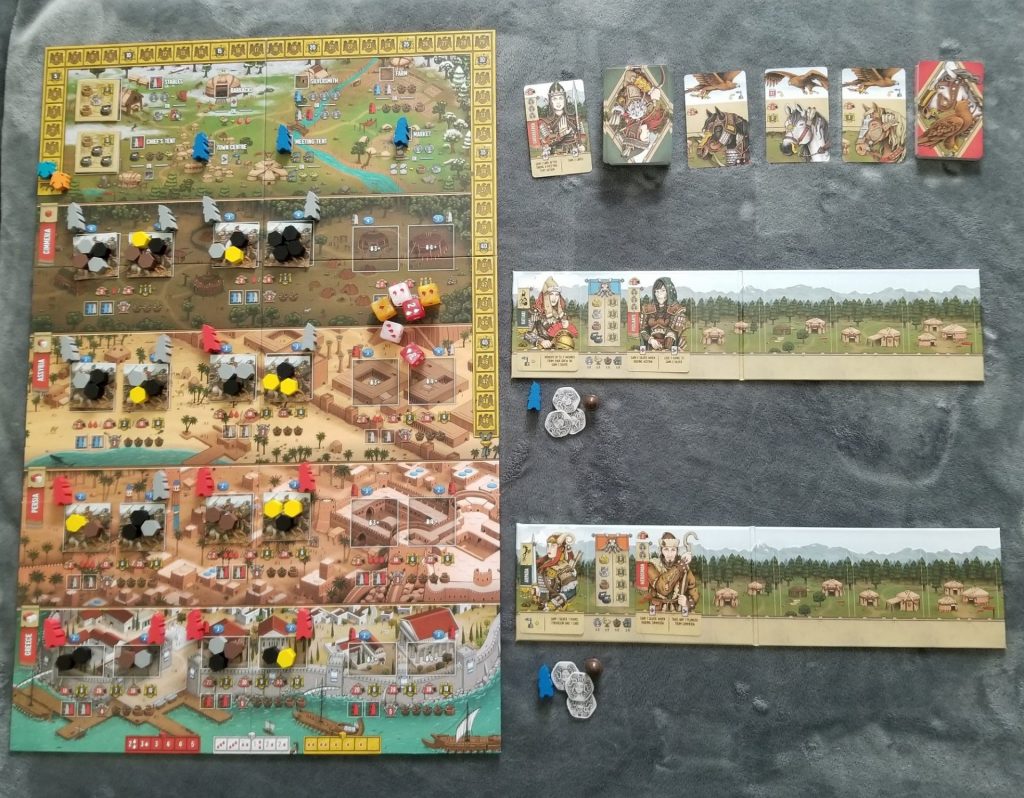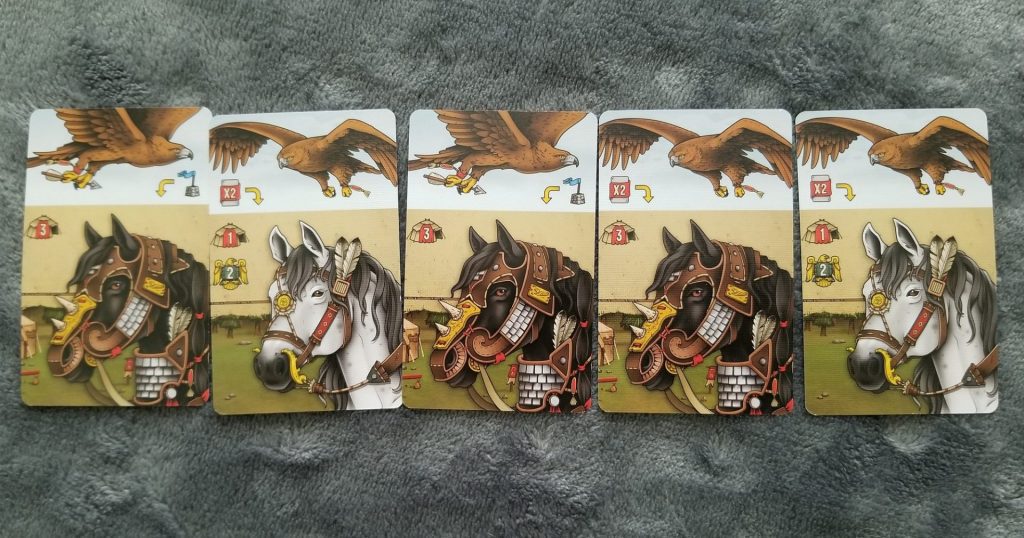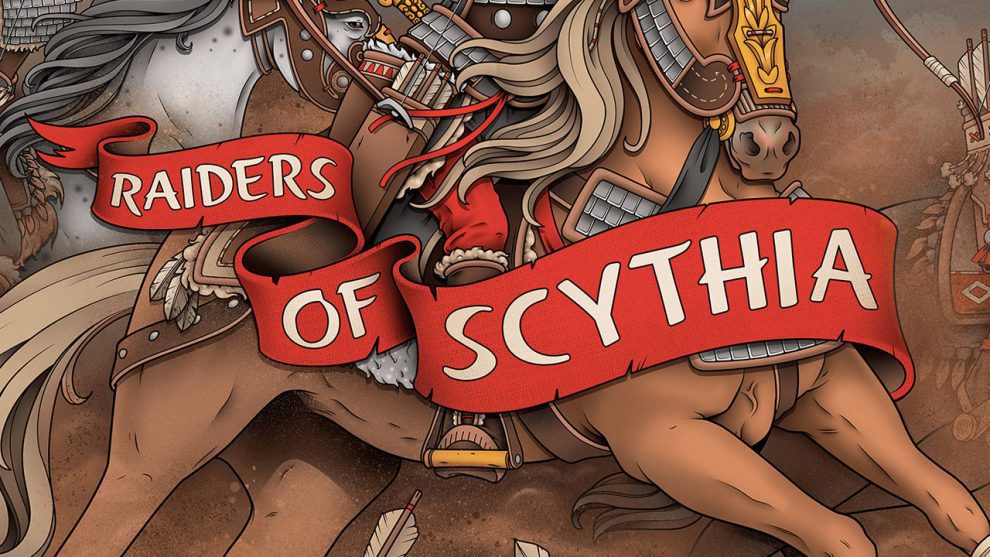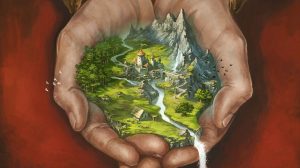Disclosure: Meeple Mountain received a free copy of this product in exchange for an honest, unbiased review. This review is not intended to be an endorsement.
In Raiders of Scythia (RoS), the first installment of Garphill Games’s Ancient Anthology series (including Hadrian’s Wall and the recently announced Legacy of Yu), players take on the roles of the titular Scythians (an empire that encompassed large swaths of Central Asia and Eastern Europe from at least the 1st century BC to the 2nd century AD) as they push south in their effort to extend their influence and power.
RoS is a worker placement game at its heart. Each player will be placing a worker on their turn to perform an action and then picking up a new worker to perform a different one. As the game begins, the action selection will mainly revolve around building up your resources and putting together a crew. As the game progresses, though, you’ll be sending your crew out to raid various locations dotted around the board in your quest to earn the most victory points by the game’s end.

If this sounds familiar to you, it’s most likely because you have played Raiders of the North Sea at some point in your life. And this is no mere coincidence. Also designed by Shem Phillips, RoS borrows many of its mechanics from its spiritual ancestor and its expansions. So much so, in fact, that instead of giving you a rundown of how to play RoS, I’m just going to highlight the similarities and differences between RoS and the games that influenced it. You can read my reviews of Raiders of the North Sea (Raiders) and its expansions if you need a general idea of how they and, by extension, RoS are played.
What’s the Same?
Fundamentally, RoS functions exactly like Raiders does. As previously mentioned, you’ll be placing the worker from your supply onto an action space, performing that action, then collecting a different worker and performing its action as well. Unless you’re raiding. Unlike the Town actions, raiding does not provide you with a secondary action.

Raiding requires you to use a specific color of worker, have a specific number of crew members, and the right amount of provisions to do so. Successful raids will reward you with some kind of resources, upgraded workers, and possibly victory points depending on your crew’s overall strength.
These upgraded workers are required to visit certain locations and can optionally be used in others. In the Town area of the game board, the results of most of the actions shown will vary depending on which type of worker is used to perform the action. And, in most cases, the available actions are very similar to those you’ll see in the Town in Raiders: produce money and/or provisions, draw cards, hire crew members, and use crew members’ unique abilities. Even the layout of the crew cards is similar with each crew member having a hiring cost, a unique raiding ability, a unique Town ability, and a certain amount of strength.

In addition to this, raiding units will acquire wounds which will lower that unit’s strength (as in the Raiders: Fields of Fame expansion) and players are able to artificially inflate their crew’s strength by using kumis (similar to the mead from the Raiders: Hall of Heroes expansion). Another attribute that has been brought over is the concept of quests (introduced in the Raiders: Hall of Heroes expansion).
What’s Different?
There are a few subtle differences between RoS and Raiders and then some not-so-subtle ones. For instance, in the Raiders: Hall of Heroes expansion, completing a quest required you to use a special action space on the expansion board. That functionality now resides in the Chief’s Tent (one of the Town actions) in RoS. The Chief’s Tent also provides one of several methods for gaining kumis. Kumis’s equivalent, mead, was only obtainable by drafting cards from the expansion board in Raiders: Hall of Heroes and, occasionally, via a crew member’s ability. Additionally, in Raiders: Hall of Heroes, quests were added to the board as various raiding locations were emptied and acted largely as just additional pathways to score more victory points. In RoS, they’re placed out during setup and actively function as one of two of the game’s endgame triggers. These are a few of the subtle differences.

As for the not-so-subtle ones, the first thing you’ll notice is the inclusion of Horses and Eagles. These are purchasable through one of the Town actions and are added to your crew board either above (Eagles) or below (Horses) a specific crew member slot. Even if that crew member should perish, the Eagles and Horses will remain, ready for the next crew member. Horses provide players with end-game victory points and strength boosts when raiding. Some Eagles will do the same, while others can double the ability of the attached crew member, or even provide an additional Town Center action that can be taken without having to discard a card.
Another difference is in the way that raids are performed. In Raiders, many of the raids required certain strength thresholds be met before they could be attempted. In RoS, this stricture has been removed and replaced with the need for wagons (obtainable via another Town action). Thematically, the further inland you’re moving, the longer your supply chain is going to need to be to fuel those activities. One of my critiques in my Raiders review was that your success at raiding (or lack thereof) was almost entirely luck dependent. If you drew good cards, you’d likely fare better than your opponents that drew poorly. It took the Hall of Heroes expansion to address and resolve this issue. By removing the strength requirement, a luck based component, from raiding and tying your success to the acquisition of wagons, an action based component, RoS levels the playing field and creates more competition over the prime raiding locations and it’s a better game for it.

Then there’s the thematic backdrop. It’s a pretty self-explanatory difference and I only mention it out of a desire to be thorough. Raiders tells a story of bands of seafaring, loot plundering Vikings. RoS tells a vastly different one. The artwork in Raiders serves that game’s theme well. The Vikings in that game evoke a sense of unbridled barbarity while the artwork for the titular raiders in RoS paints a different picture. The raiders in RoS are calculated and precise, a bullet from a sniper’s rifle as opposed to the indiscriminate spray of lead from Raiders’s Gatling gun.
What’s the Point?
This is the question that I kept asking myself as I read through the rulebook for the first time. Being a long time fan of Raiders, I couldn’t help but notice that the two games are so similar to one another. So, why would anyone choose to buy one over the other? Or, even more to the point, why would anyone want to own both games?
The answer to that first question largely comes down to preference and cost. Do you prefer Vikings over Scythians? If so, the answer as to which game you should buy is obvious. Do you prefer Sam Phillips’s stylistic art choices (RoS) or does The Mico’s unique style (Raiders) suit you better? (I think they’re both pretty stellar!) The answer to that will also make your decision apparent. And the question of price may also be the determining factor. To get the experience you’ll find in RoS, you would need to buy Raiders and both of its expansions. Those bring some mechanics into play that aren’t present in RoS and, similarly, there are some aspects of RoS (like the Horses and Eagles) that aren’t present in those other games.
And that pretty much sums up the answer to the second question. There’s really no reason for anyone to ever own both of these games unless they’re just a really big fan of Garphill Games. While there is some differentiation, I couldn’t make the argument that there’s enough to make the two games feel distinctly unique. If you already own Raiders, go get the expansions. If you don’t, then RoS is probably your better option. It’s a fine game in its own right and I’m glad that I’ve had the opportunity to play it.












David, nice summary, and I appreciate that you pinpointed the key differences. I could see the art in RoS being more suitable for certain children with sensitivities that The Mico might offend. Art is a really big factor for some people.
Do you know of other games from different publishers that have such similar nearly-identical mechanics but different themes and art? I don’t have any in my collection.
Usually, such pairs are from the same publisher (e.g., Gaia Project / Terra Mystica).
Thanks for reading my review.
The only games that immediately come to mind are Keyflower, Key to the City: London, and Key Flow.